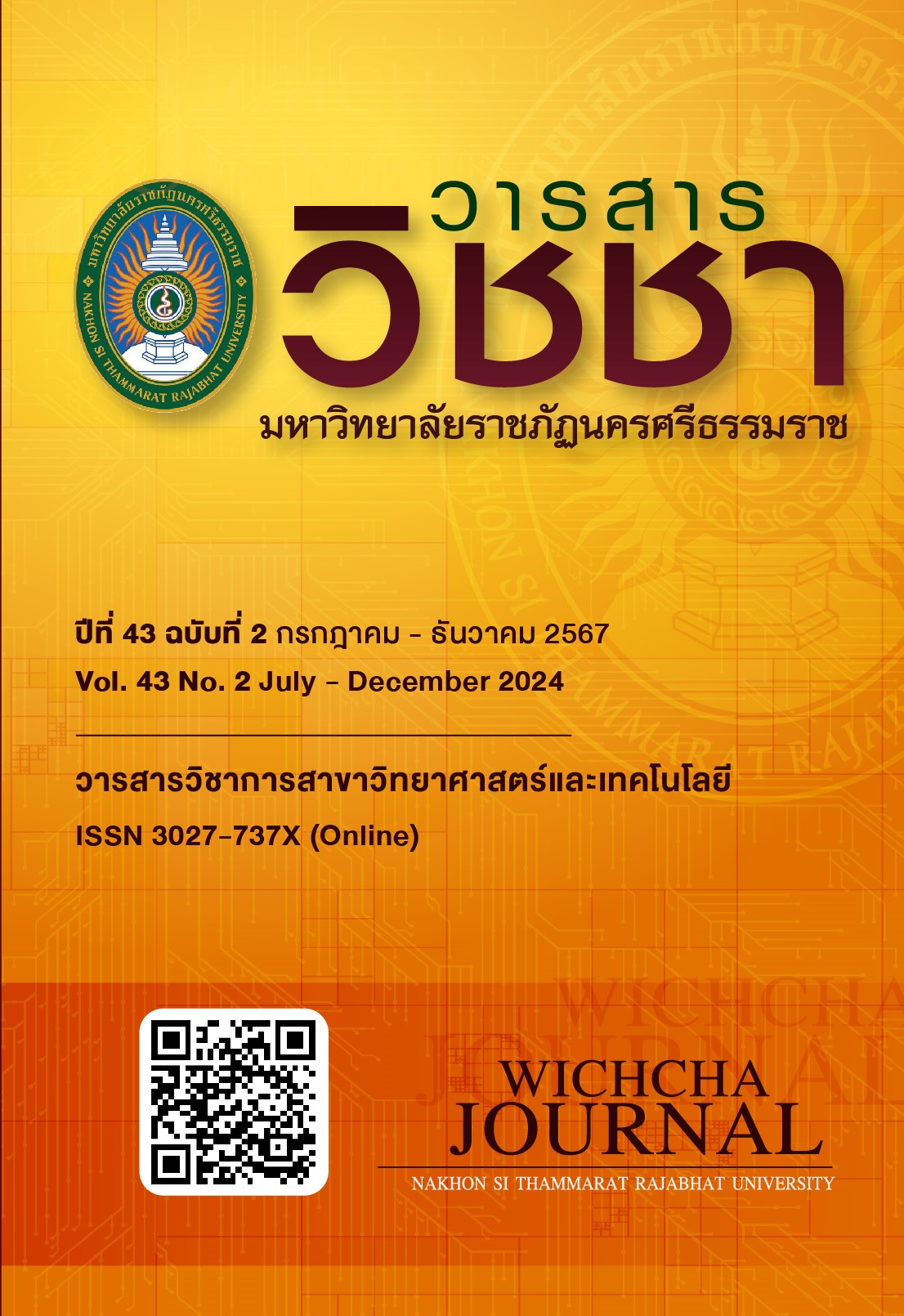Meiofauna Community from Pak Bang Na Thab Beach to Ban Bo Chon Beach, Songkhla Province
Main Article Content
Abstract
The study of meiofauna from Pak Bang Na Thap Beach to Ban Bo Chon Beach, Songkhla Province, aimed to study the diversity, density, and relationship between meiofauna and environmental factors. The samples were collected at the four stations during May, July, and September 2022. A total of 22 taxa from 8 phyla of meiofauna were found. Nematoda was the dominant group, showing the most diverse and the highest density ranging from 2-90 individuals (ind) per 10 cm², followed by Foraminifera (2-57 ind/10 cm²), and Polychaeta (1-51 ind/10 cm²), respectively. In this study, the highest diversity and density of meiofauna were found in station 1 (Pak Bang Na Thap Beach) (91.04±24.55 ind/10 cm²), while the lowest diversity and density were found in station 3 (Wang Ngu Beach) (30.81±18.61 ind/10 cm²). Environmental factors closely related to the distribution of meiofauna were the percentages of organic matter and the water temperature. However, each meiofauna taxa had a different relationship to environmental factors. When assessing environmental quality using the density proportion of nematode and copepod (N:C), station 2 (Suan Kong Beach) showed an environmental degradation, whereas the other sites still had the favorable environment.
Article Details

This work is licensed under a Creative Commons Attribution-NonCommercial-NoDerivatives 4.0 International License.
เนื้อหาและข้อมูลในบทความที่ลงตีพิมพ์ในวารสารวิชชา มหาวิทยาลัยราชภัฏนครศรีธรรมราช ถือเป็นข้อคิดเห็นและความรับผิดชอบของผู้เขียนบทความโดยตรง ซึ่งกองบรรณาธิการวารสารไม่จำเป็นต้องเห็นด้วยหรือร่วมรับผิดชอบใด ๆ
บทความ ข้อมูล เนื้อหา รูปภาพ ฯลฯ ที่ได้รับการตีพิมพ์ในวารสารวิชชา มหาวิทยาลัยราชภัฏนครศรีธรรมราช ถือเป็นลิขสิทธ์ของวารสารวิชชา มหาวิทยาลัยราชภัฏนครศรีธรรมราช หากบุคคลหรือหน่วยงานใดต้องการนำข้อมูลทั้งหมดหรือส่วนหนึ่งส่วนใดไปเผยแพร่ต่อหรือเพื่อการกระทำการใด ๆ จะต้องได้รับอนุญาตเป็นลายลักษณ์อักษรจากวารสารวิชชา มหาวิทยาลัยราชภัฏนครศรีธรรมราชก่อนเท่านั้น
The content and information in the article published in Wichcha journal Nakhon Si Thammarat Rajabhat University, It is the opinion and responsibility of the author of the article. The editorial journals do not need to agree. Or share any responsibility.
References
กรมทรัพยากรทางทะเลและชายฝั่ง. (2556). คู่มือแนวทางการปฏิบัติเบื้องต้นความรู้เกี่ยวกับชายฝั่งและการจัดการปัญหาการกัดเซาะชายฝั่งสำหรับประชาชน. ปทุมธานี: วิสุทธิ คอลซัลแตนท์.
กัสมา เจ๊ะมะ ชุติพร สุวรรณะ และสุธินี หีมยิ. (2561). ประชาคมสัตว์หน้าดินขนาดกลางบริเวณหาดแก้ว อำเภอสิงหนคร จังหวัดสงขลา. ใน การประชุมวิชาการวิทยาศาสตร์ทางทะเล ครั้งที่ 6 (หน้า 606-615). ชลบุรี: มหาวิทยาลัยบูรพา.
ณัฐกิตทิ์ โตอ่อน. (2559). สัตว์ทะเลหน้าดินขนาดเล็กในบริเวณป่าชายเลนธรรมชาติปากแม่น้ำท่าจีน จังหวัดสมุทรสาคร. วารสารวิจัยรามคําแหง, 19(1), 9-11.
ณัฐกิตทิ์ โตอ่อน. (2560). สัตว์ทะเลหน้าดินขนาดกลางในพื้นที่ป่าชายเลนปลูกปากแม่น้ำท่าจีน จังหวัดสมุทรสาคร. วารสารมหาวิทยาลัยศรีนครินทรวิโรฒ, 9(17), 13-14.
ธนพรรณ จอมบดินทร์ สุธินี หีมยิ และเอกนรินทร์ รอดเจริญ. (2565). การใช้สัตว์หน้าดินเป็นตัวบ่งชี้ทางชีวภาพเพื่อประเมินสภาวะมลพิษจากสารอินทรีย์ในแหล่งน้ำ บริเวณเกาะยอ จ.สงขลา. วารสารวิทยาศาสตร์บูรพา, 27(2), 825-849.
นิษฐนัญญ์ เทพสุข และอุทัย ปริญญาสุทธินันท์. (2558). เขื่อนกันคลื่น โครงการพัฒนาของภาครัฐกับวิถีชีวิตชุมชนบ้านบ่ออิฐ. ใน การประชุมหาดใหญ่วิชาการระดับชาติ ครั้งที่ 6 (หน้า 741-752). สงขลา: มหาวิทยาลัยหาดใหญ่.
ปฏิพัทธ์ สันป่าเป้า สุพัฒน์ พลซา วิทยา ทาวงศ์ ภาวิณี พงษ์ชัยสิทธิ์ และปิยวัฒน์ ปองผดุง. (2564). ความหลากหลายของสัตว์หน้าดินขนาดใหญ่และความสัมพันธ์ต่อปัจจัยสิ่งแวดล้อมในแม่น้ำยม. วารสารวิชชา มหาวิทยาลัยราชภัฏนครศรีธรรมราช, 40(2), 118-132.
พงศธร จันทรัตน์. (2558). ชีววิทยาทางทะเล. โครงการตำราเฉลิมพระเกียรติ พระบาทสมเด็จพระเจ้าอยู่หัว เนื่องในวโรกาสเฉลิมพระชนมายุ 82 พรรษา. สงขลา: มหาวิทยาลัยราชภัฏสงขลา.
วัลยา สารสิทธิ์ สุดารัตน์ แดงแสละ และสุธินี หีมยิ. (2561). ประชาคมสัตว์หน้าดินขนาดกลางบริเวณชายหาดบ้านทุ่งใหญ่ถึงชายหาดบ้านนาทับ จังหวัดสงขลา. ใน การประชุมวิชาการระดับชาติเครือข่ายวิจัยสถาบันอุดมศึกษาทั่วประเทศ ครั้งที่ 12 (หน้า 1078-1087). ตรัง: เครือข่ายวิจัยอุดมศึกษาภาคใต้ตอนล่าง.
วาริก เส็นนาฮู อัครเดช แหลมกา และสุธินี หีมยิ. (2560). ประชาคมสัตว์หน้าดินขนาดกลางบริเวณ หาดสะกอม จังหวัดสงขลา. วารสารวิจัยเทคโนโลยีการประมง, 11(1), 93-105.
วิลาส รัตนานุกูล. (2550). สัตว์หน้าดิน. สืบค้นเมื่อ 25 มีนาคม 2565, จาก: https://biology.ipst.ac.th/?p=816.
องค์การบริหารส่วนจังหวัดสงขลา. (2557). สงขลา เมืองมนต์เสน่ห์สองฝั่งทะเล 50 จุดหมายแห่งความประทับใจ. สงขลา: โฟโต้สแควร์แอนด์กราฟฟิค.
Albuquerque, E.F., Pinto, A.P.B., Perez, A.Q. and Veloso, V.G. (2007). Spatial and temporal changes in interstitial meiofauna on a sandy ocean beach of South America. Brazilian Journal of Oceanography, 55(2), 121-131, doi: http://dx.doi.org/10.1590/S1679-87592007000200005.
Giere, O. (1993). Meiobenthology: The microscopic fauna in aquatic sediment. (2nd ed). Berlin: Springer-verlag Berlin Heidelberg.
Harguinteguy, C.A., Cofré, M.N. and Pastor de Ward, C.T. (2012). Change in the meiofauna community structure of sandy beaches of the Nuevo Gulf (Chubut, Argentina). Papéis Avulsos de Zoologia (São Paulo), 52(34), 411-422, doi: https://doi.org/10.1590/S0031-10492012021400001.
Higgins, R.P. and Thiel, H. (1988). Introduction to the study of meiofauna. Washington, D.C.: Smithsonian Institution Press.
Kenny, A.J. and Sotheran, I. (2013). Characterising the physical properties of seabed habitats. In Eleftheriou A. (Ed.). Methods for the study of marine benthos, pp. 47-95. Chichester: John Wiley & Sons, Ltd.
Martins, M.O., Almeida, T.C.M. and Domenico, M.D. (2015). Vertical distribution of meiofauna on reflective sandy beaches. Brazilian Journal of Oceanography, 63(4), 469-480, doi: https://doi.org/10.1590/S1679-87592015095606304.
Maxar Technologies. (2024). Location of the sampling sites at Pakbang Nathab beach to BanBochon beach, Songkhla province. Retrieved 30 March 2024, from: https://www.google.com/maps/@7.0146002,100.771371,20085m/data=!3m1!1e3!5m1!1e4?authuser=0&entry=ttu.
Nelson, D.W. and Sommer, L.E. (1982). Total carbon, organic carbon and organic matter. In Sparks, D.L., Page, A.L., Helmke, P.A., Loeppert, R.H., Soltanpour, P.N., Tabatabai, M.A., Johnston, C.T. and Sumner, M.E. (Eds.). Methods of soil analysis, part, chemical and microbiological properties, pp. 961-1010. Madison: ASA-SSSA.
Pinedo, S., Sardá, R. and Martin, D. (1997). Comparative study of the trophic structure of soft-bottom assemblages in the Bay of Blanes (Western Mediterranean Sea). Bulletin of Marine Science, 60(2), 529-542.
Vincx, M. and Heip, C. (1991). The use of meiobenthos in pollution monitoring studies: A review. In Rees, H.L., Heip, C., Vincx, M. and Parker, M.M. (Eds.). Benthic communities: Use in monitoring point source discharges, techniques in marine environmental sciences, no.16, pp. 50-67. Copenhagen: International Council for the Exploration of the Sea.

